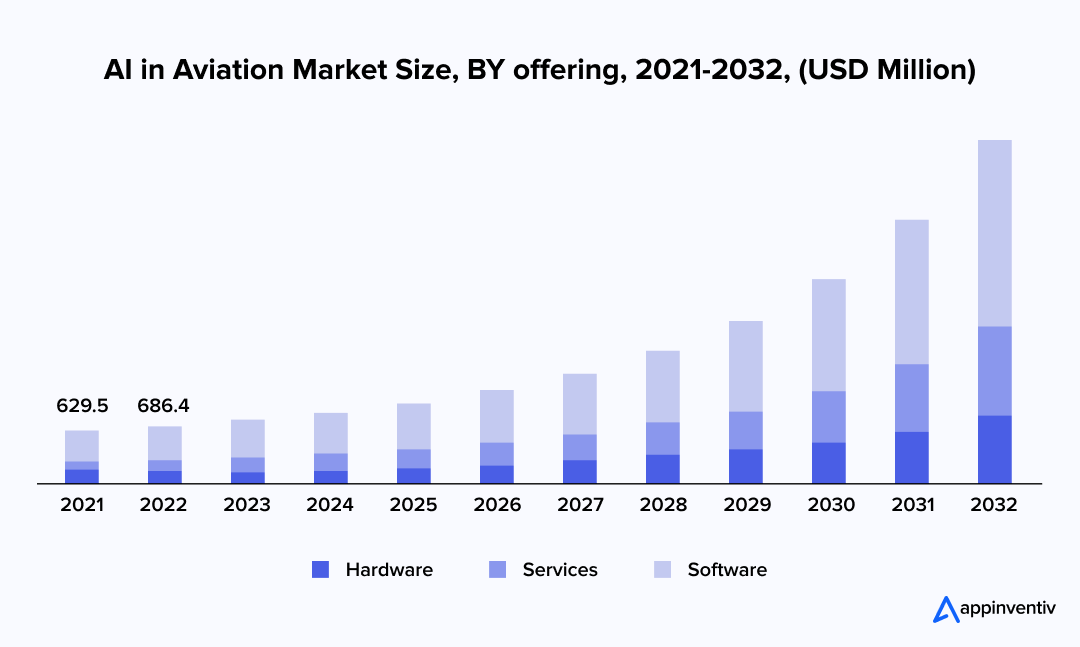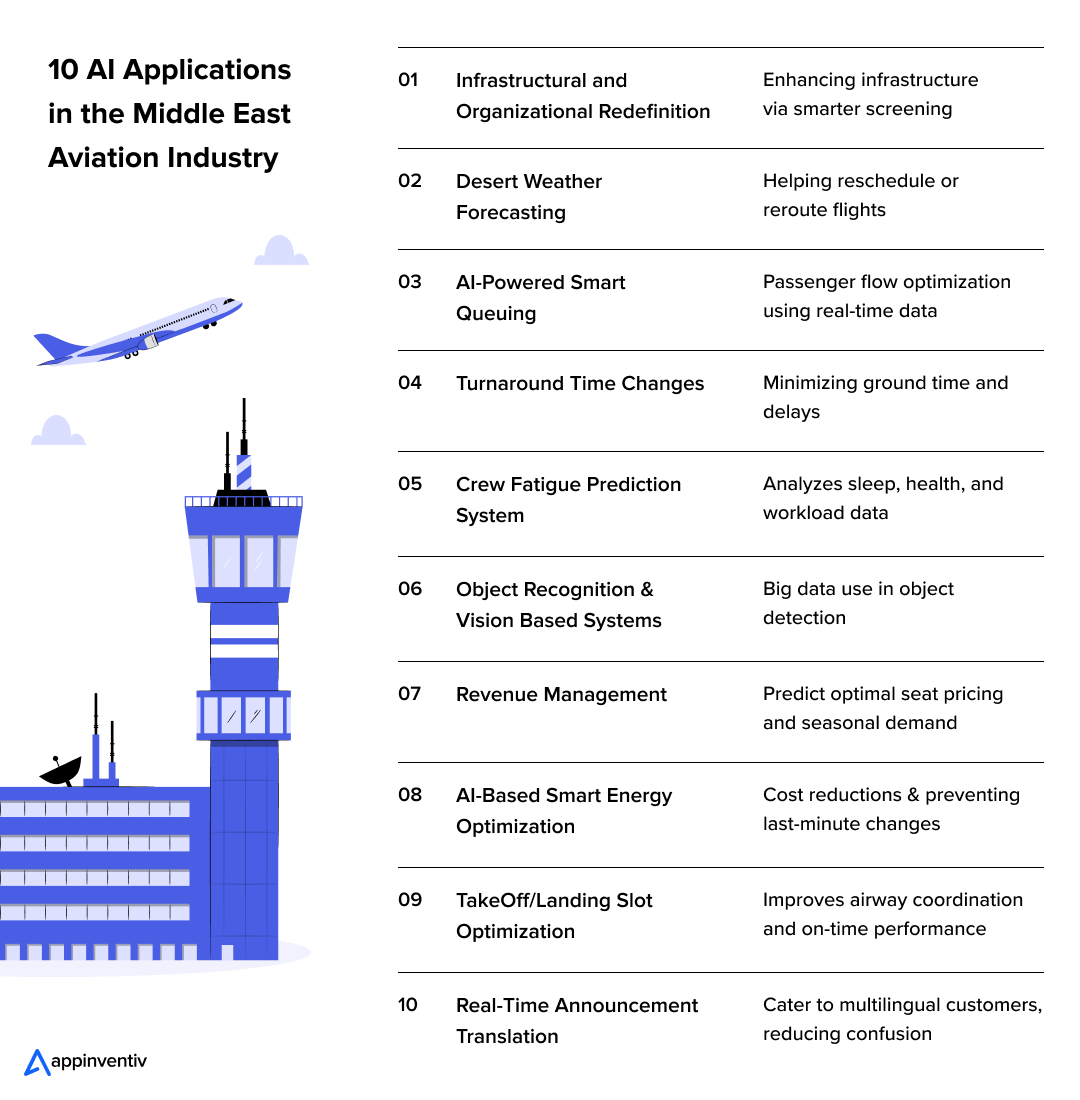Over the recent years, the Middle East region, particularly Saudi Arabia, has successfully integrated AI into its aviation sector. While facial recognition, IoT, and biometric systems have already been integrated with airports, integrating AI in the UAE aviation sector will transform security and operational efficiency.
MDPI highlighted four relevant industry insights in the aviation sector.
- Airports such as Dubai International Airport extensively use Facial Recognition Systems integrated with AI to accurately verify passenger identities during facial checks, thus minimizing human error and intervention.
- Predictive Analytics is being utilized through AI in aviation to (i) optimize gate assignments, (ii) anticipate passenger flow patterns, and (iii) improve maintenance processes. This collectively helps in resource allocation and efficiency improvements.
- The inclusion of Artificial intelligence in the Middle East aviation industry, particularly in baggage handling, has resulted in significant improvements in accuracy and mishandling occurrences. This collective unification streamlines the process, ensuring timely and secure passenger baggage handling.
- The aviation industry leverages IoT through devices that proactively manage parameters such as Crowd Density and Airport Cleanliness with integrated AI systems. Subsequent AI algorithms process the previously mentioned data to detect crowded areas or bottlenecks in real time, followed by the activation of alert systems.
It also revealed that integrating AI in the Middle East aviation industry has reduced operational, construction, and labor costs by 5% to 10%.
“I think the UAE has been an early mover in AI. I saw incredible progress today in applying AI to their energy system and a big vision for their future.”
By Chris Wright, US Secretary of Energy
This industry is also experiencing incremental AI-driven aviation innovations in the Middle East due to the use cases and level of complex dependency involved, be it security measures or data collection of everyday footsteps entering and exiting the premises.
Stick with us if you want to be ahead of the curve and make some serious moves. Here are ten killer AI use cases in the Middle East aviation sector that are transforming the industry and setting new global standards.
AI in Aviation Market Forecast
According to Global Market Insight, the AI market in aviation was valued at USD 686.4 million in 2022 and is projected to register a CAGR of over 20% between 2023 and 2032.

Moreover, a news report by Businesswire, sourced from IDEX 2025, stated that ADASI, a leader in UAV system manufacturing, announced its successful adoption of two advanced flight technologies by Abu Dhabi’s VentureOne:
- Perceptra (a GPS-less navigation system)
- Saluki (a secure flight control system)
With this update, VentureOne aims to offer enhanced resilience, precision, and security for autonomous aerial operations. It collectively aimed to rely LESS on GPS (due to frequent navigation errors) and MORE on AI-powered autonomous solutions.
Aviation Industry’s Significance in the Middle East: A Brief Overview
The year 2024 saw some significant improvements in the rankings and performance of airlines in the Middle East region. Saudi Arabia climbed to third place from sixth place, with an OTP (On-Time Performance) of 88.22%.
- Qatar Airways moved to fifth place from ninth place, with an OTP of 81.01%, experiencing an 11-point increase from 2023. In addition, Royal Jordanian remained consistent, in third place, with an OTP of 86.11%.
- Oman topped the rankings with an OTP of 93.35% and a completion factor of 99.75%, tracking out of 3,005 operated flights. [Source: Aviation Business]
These insights prove the progressive growth of the Middle East aviation industry. Furthermore, insights and history also reveal how Saudi Arabia is highly receptive to including new technologies and structural improvements in its aviation department to drive growth and operational efficiency further, to rank high alongside the rest of the world.
10 AI Use Cases in the Middle East Aviation Sector
Dubai is constructing the world’s largest airport terminal, with 400 gates and five runways. This standalone proves that the inclusion of AI is not only subject to technological incorporations but also involves an entire airport design redefinition, thereby not limited to any specific construction or design limitation. This brings us to the instances of incorporating AI applications in the Middle East aviation industry:
 Infrastructure Improvements and Organizational Redefinition
Infrastructure Improvements and Organizational Redefinition
The past two decades have seen some changes in airports’ organizational structure due to
- Innovative design measures
- Security screening mechanisms
- Passenger parking systems
Though AI inclusion would not directly affect the airport’s organizational design part, it would assist in a fragmented manner, adjacent to combining the amalgamation of various factors that would jointly assist in design redefinition. AI in flight operations in the Middle East is becoming highly prevalent in enhancing security and endpoint detection, making airports evolve operationally and structurally.
For instance, security and screening are two aspects of design redefinition that could affect airports’ future infrastructure. Security aspects can be complemented through AI and ML, trained on past security incidents, thus identifying patterns related to suspicious items or behaviors. Similarly, facial recognition systems can compare facial data to known and registered databases, enhancing operational processing.
In addition, biometric technology and computed tomography (CT) are collectively used at checkpoints to cater to various detection endpoints that could potentially improve airport inspection. These collective additions significantly impact operational infrastructure and efficiency, speeding up everyday processes.
Relevant Market Insights
MDPI demonstrates using an AI framework to classify aviation construction projects using ML. It revealed that AI and ML algorithms can estimate (based on their analysis) schedules and resource allocation based on subsequent aviation project requirements, showcasing cost-intensive patterns.
- AI integration within gate designs and allocation can help estimate the most appropriate airport design (based on historical data from numerous feeds) and the expected number of passengers per day.
- It significantly helps optimize the allocation of security resources and entry-exit barriers.
- Among the core benefits of AI in Middle East aviation is the ability to turn complex passenger flow data into actionable insights, improving passenger experience at busy points.
Desert Weather Forecasting & Turbulence Avoidance
Sand and dust storms have always been an operational risk for the Middle East aviation industry. These storms drastically reduce visibility, leading to flight delays and cancellations. Dust particles’ ingestion can cause erosion and engine clogging, thus increasing maintenance requirements. In addition, dust accumulation in sensors can also impair aircraft performance, halting air traffic control operations.
However, including AI in the Middle East aviation industry transforms the weather prediction scenario. AI-powered models improve dust storm forecasting by analyzing real data based on insights from wind patterns, soil dryness, satellite images, etc. These predictions tend to help reschedule or reroute flights before the storm hits.
Regarding turbulence avoidance, ScienceDirect revealed that such ML techniques can streamline and optimize combinations of turbulence indices to improve prediction qualities.
Relevant Market Insights
Emirates Airline improves crew and passenger safety by partnering with the IATA Turbulence Aware platform. The initiative focuses on providing real-time turbulence data to avoid dangerous areas mid-flight. This strategic move aims to reduce injuries caused by turbulence via live turbulence forecasts.
To the benefit, Emirates revealed an approximate 60% profit increase to $4.69 billion and transported 51.9 million passengers, proving their strong operational performance. [Source: Gulf Business]
AI-powered Smart Queuing (Security & Immigration)
Managing passenger flow through busy airports is no small feat. Effective airport and aircraft management is something every aviation department strives for. Thus, smart queuing is powered by AI web, computer vision, and real-time data analytics for aviation to manage passenger flow through immigration and security checkpoints.
Though a computer vision model is mainly used in such analytics, reinforcement learning is also utilized to manage queues dynamically. This model is used in dynamic decision-making and consumes optimal queue assignment strategies based on past outcomes and queue performance data.
Via real-time data, integration of Artificial Intelligence in the Middle East aviation industry can predict peak congestion times by identifying trends and patterns, and the organization can then further assign the staff more efficiently, reducing operational costs and enhancing overall airport functional capacity. This entire unification of AI in airport operations tends to offer travelers a more seamless experience, from check-ins to boarding.
Relevant Market Insights
Considered among the busiest airports in the world, Dubai Airport is significantly harnessing the boom of Middle East aviation AI trends, particularly Smart Queuing, to improve customer waiting time and streamline security queues. A particular example of this is the “Passport Control at Dubai Airports” during the second phase of COVID-19. Their joint effort at deploying face and iris recognition profoundly reduced passport control formalities to seconds.
In addition, Etihad Airways develops a cohesion of biometrics, facial recognition, and voice-activated self-service for passengers to enjoy a queue-free airport experience. Note that it is not always the execution of a particular ML model that caters to a problem, but a combination of various models (NWP, Facial Recognition, Voice Recognition, Biometrics) that provides a unified and catered experience or solution to a particular problem.
Incremental Changes in Turnaround Times
Aviation is not only about passenger travel and profitability, but also a lifeline on which the entire region depends regarding overseas business transactions. It’s relevant that revenue opportunities are missed for every minute an aircraft spends on the ground.
Rapid Growth and Fast Passenger Volumes define this industry, particularly for the Middle East, and streamlining this set of operations is not an add-on but a necessity. This emerging aviation technology in the Middle East is highly necessary for operational efficiency.
For example, AI systems can use real-time information and historical data to make accurate predictions about flight delays, constellations, or even baggage handling times (which comes under the same umbrella of organizational redefinition). In addition, through a centralized platform powered by AI, miscommunications can be reduced or even eliminated, subject to timely notifications and updates, thus leading to quicker responses to operational challenges.
Relevant Market Insights
The 2024 Turnaround Benchmark Report from Assaia proves how AI is on its way to continuously improving operational efficiency and reducing delays. Employing AI-powered systems has significantly helped Middle Eastern aviation monitor and effectively manage ground operations in real time. Their report revealed that the inclusion of AI-driven aviation innovation in the Middle East has significantly contributed to:
- 6% decrease in ground delays
- A 25% increase in average turns per gate results in optimized gate utilization.
Moreover, GE Aerospace’s AI initiatives in the Middle East also incorporated AI to improve their turnaround times. After their cohesive effort, they developed an MVP software integrated with AI, which reduced ABM response time by more than 60%. (Source: GE Aerospace)
Crew Fatigue Prediction Systems
The use case of integrating Artificial intelligence in the Middle East aviation industry is the strategic prediction of crew fatigue. This strategic integration aims to improve flight safety through better fatigue monitoring. Necessitated an awareness of the increasing mental load on pilots due to complex information processing. It emphasizes the significance of the ethical use of AI technologies in a fundamental way.
Factors and touchpoints like sleep patterns, previous flight data, health history, and food intake history before flight can be beneficial in analyzing and predicting the pilot’s health while in transit. Moreover, integrating AI systems in the Middle East aviation market with crew scheduling systems to monitor factors like sleep patterns, workload distribution, etc., could result in a more robust and mishap-proof system.
Relevant Market Insights
The civil aviation industry is highly data-driven, and AI inclusion in it is here to accelerate this transformation through three major steps:
- Smart analysis of aviation knowledge
- Multimodal information processing
- Improved human-computer interaction
Preprints.org provides a detailed analysis of this amalgamation. It mentions how AI and ML models can use vast amounts of safety reports and other data from various sources to create a predictive model that enables early warnings for potential hazards that could happen on a flight. Moreover, a prominent example of Etihad Airways is found here. The company has trialed efficient monitoring of crew status by collecting data from flight reports, maintenance, and miscellaneous training activities. (Source: SITA)
Object Recognition and Vision-Based Navigation
Over recent years, AI and ML algorithms have been used for significant safety benefits. With big data, AI in the Middle East aviation industry considers various variables and data sources. With AI’s help, the air traffic system can consider air traffic and weather conditions and make the required decisions based on those data sources.
Similarly, object recognition works but with slightly different ML algorithms. It uses a computer vision model (real-time visual data) through AI cameras and identifies potential markups. It helps determine runway obstacles mid-air (birds, drones). The combined technology can also help in sand and dust storms, which are highly prevalent in the Middle East.
Relevant Market Insights
According to King Abdullah University of Science and Technology (KAUST) in Saudi Arabia, the study titled ‘A Robust Vision-based Runway Detection and Tracking Algorithm for Automatic UAV Landing’ is one example of a serious study that shares the relevance of AI integration with autonomous aircraft navigation systems.
The paper shares that the specific ML algorithm used here is a strategic combination of computer vision and classical Kalman Filtering. It helped UAVs detect and track runways during landing and takeoff, all without GPS assistance. Though the study revolved around drones, it can also be adapted for manned on-demand aircraft.
Bonus Read: AI in Drones: Benefits, Use Cases, and Challenges
Revenue Management
Revenue management is the science of selling a particular or right seat to the right customer at the right time and price. ML algorithm, subject to this benefit, utilizes booking patterns, historical data, and usual customer preferences to predict the optical seat prices based on day, weather, and peak seasons. Popular airlines like Saudia and Emirates are well known to utilize AI-based pricing models to shift fare structures dynamically. This feature turns extremely useful in demand seasons like Hajj, Expo events, or peak travel months.
In addition, AI segments customers based on their booking and spending habits. It analyzes customers’ historical data and then provides them with targeted offers, discounts, and seat upgrades.
Relevant Market Insights
Etihad Airways was named the 2024 PROS Customer Outperformer Award winner in the Profit Booster category. The company implemented PROS RM, an AI-powered Revenue Management tool that forecasts and optimizes bid prices. The solution single-handedly optimizes and manages demand fluctuations. The airlines successfully managed to achieve boosted profitability and margins. (Source: ETIHAD)
Middle East Airlines also adopted a revenue management system powered by AI to optimize pricing strategies, named “Amadeus Altéa Segment Revenue Management”. The system relies on sophisticated algorithms, combining volume factors like trends, seasons, etc, with customer choice factors to optimize a final, highly accurate forecast that can be employed for the company’s business decisions. It gives a rich suite of analytics to derive a particular market strategy for enhanced revenue growth. (Source: Amadeus)
Smart Energy Optimization Using AI
Integrating AI in the Middle East aviation industry can significantly benefit variables such as energy flexibility and energy demand optimization. Natural resources are under threat, and there is no better time to utilize AI and use it in conjunction to achieve energy optimization. Abu Dhabi International Airport is a significant example of AI and ML inclusion to drive sustainability and precision planning.
It utilized Building Information Modeling (BIM) to reduce overall project costs. It facilitated early detection, which prevented expensive last-minute changes.
Relevant Market Insights
The above example of Abu Dhabi International Airport, particularly the Midfield Terminal, falls exactly into one of the examples of successful implementations. It uses Delmatic’s open protocol LON, DALI, and BACnet lighting management system to efficiently manage and monitor lighting across the entire terminal efficiently, thus achieving significant savings (Source: Delmatic).
It also helped achieve significant HVAC optimization. The integration of BMS (Building Management Systems) and SCADA (a Control System Architecture) also assisted in the cohesive optimization of heating, ventilation, and air conditioning operations.
Bonus Read: How the Departure Control System in Airlines Can Help in Cost Optimization
Takeoff/Landing Slot Optimization for Aircraft
Airports are beginning to utilize the benefits of AI integration to manage takeoff/landing slot optimization. Managing this aspect of the aviation industry, particularly in the Middle East, has become important to coordinate landing and takeoff slots across multiple airports effectively. By leveraging AI and diversified analytics:
- It helps in airway optimization.
- Enhancing on-time performance
Delays tend to directly affect a particular airline’s revenue and overall reputation. Sometimes, when the demand for slots exceeds the airport’s supply, the situation could be labeled “capacity-constrained.” Thus, management becomes important in such scenarios.
Relevant Market Insights
King Salman International Airport in Riyadh will be a popular example of the abovementioned integration. Linda Schucroft, Vice President of Innovation and Customer Experience, King Salman International Airport, mentions the goal to transform aviation through AI and customer-dedicated personalizations. She emphasizes the importance of leveraging AI and ML technologies to future-proof the aviation industry from mishaps and revenue pitfalls, embracing smooth operations while maintaining profitability.
In addition, in collaboration, Riyadh Airports Company and ADB SAFEGATE also planned to launch an AI-based airport management platform at KKIA to take full control of the operations. 2024 saw the launch of the Baseer Turnaround Management System to optimize over 30 key operational processes. (Source: AACO)
Real-Time Airport Announcement Translations
Though considered an exclusive feature, real-time announcement translations are a growing trend aimed at catering to multiple passengers simultaneously. Multilingual aviation hubs cater to millions of international travelers annually, particularly in the Middle East. AI-powered translation models first process live public announcements and then convert them into multiple languages by using models like:
- Natural Language Processing
- Neural Machine Translation
- Speech Recognition
- Text-to-Speech Synthesis
The overall benefit is that it minimizes confusion and enhances operational capabilities by reducing staff workload.
Relevant Market Insights
An article by International Airport Review mentioned the importance of normalizing the integration of AI systems to translate airport announcements in real time. It emphasized the importance of integrating NLP and NMT models to cater to different passengers and make them feel noticed and catered to.
AviaVox, an automated announcement system, also studied and researched the HOW of improving airport announcements, which was coined as personal guidance. Based on the passengers’ nationalities derived from the data from certain congestion-sensitive areas, they aimed to cater to language announcements (Source: International Airport Review).
Cost Estimation of Integrating AI in the Middle East Aviation Industry: Expense Breakdown Brief
The cost estimation of AI inclusion in the aviation industry depends on the project scope you are looking for. For example, small-scale implementation includes features like:
- Chatbot-based customer service
- Automated scheduling
- Basic airport predictive maintenance tasks
It could start at $10,000 (36730 AED) and scale based on the increasing complexity and requirements of your aviation project. Moreover, if the requirement exceeds departmental AI projects, including security, maintenance, crew scheduling, and passenger experience, the cost of implementing AI in the Middle East Aviation Industry could range and exceed $500,000 (1836500 AED).
This would involve Infrastructure and Computational Resources, AI Model Training, AI development, and subsequent integration with Existing Systems and Processes.
While the above-mentioned costs are straightforward and involve direct implementations of the required features, the cost for Custom AI Model Development and its Integration with Dedicated Aviation Software tends to range around $5 million (18365000 AED).
But Why?
The answer lies in the level and amount of data generated through various dataset sources, such as aircraft sensors, weather feeds, aircraft slotting, biometrics, gate allocation, visual feed sensors, and more.
- In addition, custom AI models utilize advanced computational resources combined with a highly specialized pool of data scientists, ML engineers, UI/UX designers, Aviation system experts, and much more.
- Adherence to regulatory and safety compliance requirements, complemented with continuous feedback, training, and governance, are other cost factors that are considered in the overall development of either a Custom AI model or straightforward Aviation Software for your company.
How Appinventiv Can Help Your Aviation Business Grow?
Being a leading product and custom AI development company, we can assist your Aviation business by leveraging state-of-the-art AI Development Services in Dubai to incorporate into your business. Our company excels in providing leading aviation software and custom AI model integration services via four strategic steps:
- We focus on understanding your custom requirements. We analyze your niche and then craft aviation software development services.
- We focus on developing your business’s architectural framework, followed by Agile Methodology, and slowly begin to work on the backend and the design functionality.
- We focus on testing the developed software through real-world scenarios, identifying any potential bugs or inconsistencies, and then releasing it.
- We remain throughout the journey, from understanding initial requirements to providing post-production maintenance and support services.
- We ensure that your business remains live and running while also maintaining and constantly upgrading your software through the latest AI model integration.
It’s time to optimize your aviation operations and improve your passenger experience to stay competitive in today’s already-evolving aviation landscape. Connect with our experts today to discuss your custom needs.
FAQs
Q. Aren’t there any ethical concerns regarding AI use in airport surveillance and facial data collection?
A. Though AI inclusion in security has incrementally revolutionized security, mass surveillance can lead to pervasive monitoring without consent, data misuse, and biases. Moreover, ethical concerns regarding including biased datasets in ML algorithms have also been raised.
This is because a biased dataset entered into an ML algorithm will often produce a prejudiced outcome. Fair use and collection of data are mandated, and more regulatory compliance is needed in such scenarios. Accountability and transparency are currently lacking and centered around the fair use of data processed via AI and ML algorithms.
Q. How will AI integration affect the job market in the aviation industry in the Middle East?
A. Such questions are often a common concern whenever the AI integration conversation centers around. However, the scenario isn’t completely discussed. Though AI automates repetitive and routine tasks like baggage handling, security screenings, etc., the work of already existing baggage handlers can be transformed into system monitoring and interpretations.
The term used in such scenarios is “job redefinition.” In addition, while some of the existing roles may diminish, new roles termed AI operators, Maintenance techs, and AI ethicists would emerge, thus not directly affecting the job market, but redefining it.
Q. How does AI predict and manage extreme weather changes in real-time?
A. AI observes and manages extreme weather changes and conditions via ML models, real-time sensor data, and satellite imagery to forecast and react to weather events like sandstorms, dust storms, flash floods, etc.
Based on istorical climate databases, Deep Learning and Numerical Weather Prediction models analyze patterns in soil moisture, wind patterns, temperature fluctuations, etc. They are then fed into centralized AI platforms in real time.
Q. What are the potential challenges of AI in the Middle East Aviation Industry?
A. Despite its advantages, AI comes with its own set of challenges that should be navigated carefully. Firstly, it’s the unavailability of reliable, quality-centric data to feed into the models. Vast data sets are required for consistent integration. Secondly, regulatory and compliance barriers are among the biggest challenges of AI in the Middle East aviation industry. Introducing AI in aviation requires smooth alignment with regulatory bodies. Other challenges include organizational resistance, outdated legacy systems, etc.
Product Development & Engineering
IT Managed & Outsourcing
Consulting Services
Data Services
Didn't find what you're looking for? Let us know your needs, and we'll tailor a solution just for you.






















 Infrastructure Improvements and Organizational Redefinition
Infrastructure Improvements and Organizational Redefinition




